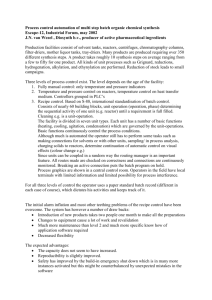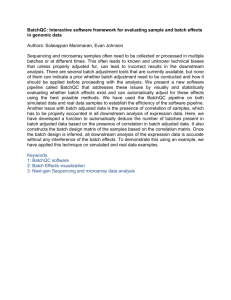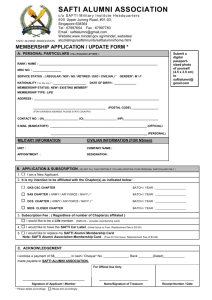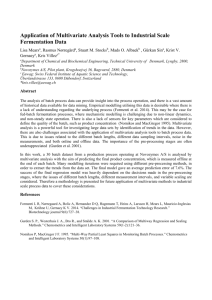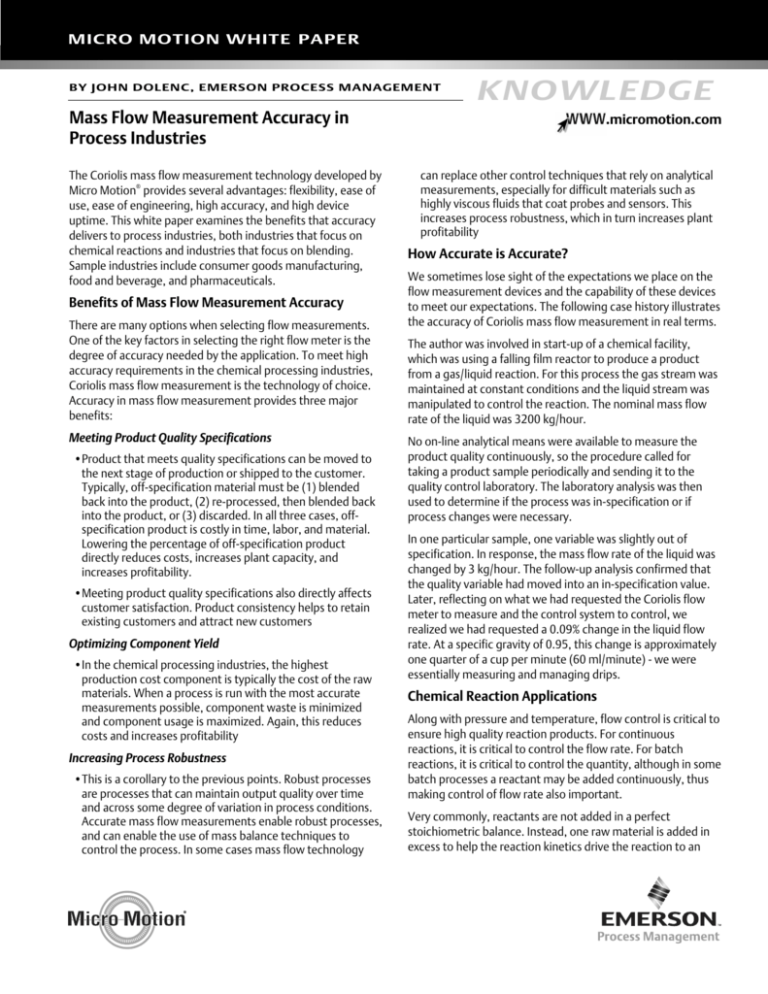
MICRO MOTION WHITE PAPER
BY JOHN DOLENC, EMERSON PROCESS MANAGEMENT
KNOWLEDGE
Mass Flow Measurement Accuracy in
Process Industries
The Coriolis mass flow measurement technology developed by
Micro Motion® provides several advantages: flexibility, ease of
use, ease of engineering, high accuracy, and high device
uptime. This white paper examines the benefits that accuracy
delivers to process industries, both industries that focus on
chemical reactions and industries that focus on blending.
Sample industries include consumer goods manufacturing,
food and beverage, and pharmaceuticals.
Benefits of Mass Flow Measurement Accuracy
There are many options when selecting flow measurements.
One of the key factors in selecting the right flow meter is the
degree of accuracy needed by the application. To meet high
accuracy requirements in the chemical processing industries,
Coriolis mass flow measurement is the technology of choice.
Accuracy in mass flow measurement provides three major
benefits:
Meeting Product Quality Specifications
•Product that meets quality specifications can be moved to
the next stage of production or shipped to the customer.
Typically, off-specification material must be (1) blended
back into the product, (2) re-processed, then blended back
into the product, or (3) discarded. In all three cases, offspecification product is costly in time, labor, and material.
Lowering the percentage of off-specification product
directly reduces costs, increases plant capacity, and
increases profitability.
•Meeting product quality specifications also directly affects
customer satisfaction. Product consistency helps to retain
existing customers and attract new customers
Optimizing Component Yield
•In the chemical processing industries, the highest
production cost component is typically the cost of the raw
materials. When a process is run with the most accurate
measurements possible, component waste is minimized
and component usage is maximized. Again, this reduces
costs and increases profitability
Increasing Process Robustness
•This is a corollary to the previous points. Robust processes
are processes that can maintain output quality over time
and across some degree of variation in process conditions.
Accurate mass flow measurements enable robust processes,
and can enable the use of mass balance techniques to
control the process. In some cases mass flow technology
.micromotion.com
can replace other control techniques that rely on analytical
measurements, especially for difficult materials such as
highly viscous fluids that coat probes and sensors. This
increases process robustness, which in turn increases plant
profitability
How Accurate is Accurate?
We sometimes lose sight of the expectations we place on the
flow measurement devices and the capability of these devices
to meet our expectations. The following case history illustrates
the accuracy of Coriolis mass flow measurement in real terms.
The author was involved in start-up of a chemical facility,
which was using a falling film reactor to produce a product
from a gas/liquid reaction. For this process the gas stream was
maintained at constant conditions and the liquid stream was
manipulated to control the reaction. The nominal mass flow
rate of the liquid was 3200 kg/hour.
No on-line analytical means were available to measure the
product quality continuously, so the procedure called for
taking a product sample periodically and sending it to the
quality control laboratory. The laboratory analysis was then
used to determine if the process was in-specification or if
process changes were necessary.
In one particular sample, one variable was slightly out of
specification. In response, the mass flow rate of the liquid was
changed by 3 kg/hour. The follow-up analysis confirmed that
the quality variable had moved into an in-specification value.
Later, reflecting on what we had requested the Coriolis flow
meter to measure and the control system to control, we
realized we had requested a 0.09% change in the liquid flow
rate. At a specific gravity of 0.95, this change is approximately
one quarter of a cup per minute (60 ml/minute) - we were
essentially measuring and managing drips.
Chemical Reaction Applications
Along with pressure and temperature, flow control is critical to
ensure high quality reaction products. For continuous
reactions, it is critical to control the flow rate. For batch
reactions, it is critical to control the quantity, although in some
batch processes a reactant may be added continuously, thus
making control of flow rate also important.
Very commonly, reactants are not added in a perfect
stoichiometric balance. Instead, one raw material is added in
excess to help the reaction kinetics drive the reaction to an
Page 2 of 6
MICRO MOTION WHITE PAPER
optimum conversion. The ratio between the reactants is called
the mole ratio. For example, one mole of reactant A (Molecular
Weight 255) is to be reacted with one mole of reactant B
(Molecular Weight 85), with a mole ratio of 1.03 of reactant A
to reactant B. The flow rates would be:
Reactant A 1.03 X 200 = 262.65 mass unit/time unit
Reactant B 1.00 X 85 = 85 mass unit/time unit
It is very common to specify the mole ratio to the hundredths
place. Some manufacturers even control the mole ratio to the
thousandths place.
Case Study: Importance of Mole Ratio
The following case history illustrates why close adherence to a
mole-ratio specification is important.
A detergent facility was producing liquid dishwashing
detergents in 10,000-gallon mixing vessels. During the
production of a certain detergent the contents gelled in the
mixing vessel. The total cost - in labor to empty and clean the
mixing vessel, in raw materials, in shipping and disposal, and in
lost production time - was estimated in the hundreds of
thousand dollars.
The company's R&D department was tasked with determining
what caused the product to gel. After a lengthy investigation
the problem was traced to one of the raw material surfactants
in the detergent. This particular surfactant was produced i
n-house in a newly commissioned production unit. The R&D
chemists found that a side reaction was occurring during the
sulfation process. They also determined that if the mole ratio
was increased from 1.01 to 1.02 the side reaction did not
occur. The change was made in the production unit and
proved to be successful.
Case Study: Batch Production
As was stated earlier, in the case of batch reactions, the
quantity of the raw material, rather than the flow rate, is
typically the critical measurement. Many older facilities use
load cells to measure the amount of reactant transferred to
the reaction vessel. Load cells can be an accurate method and
are very good for powder additions, with either the receiving
vessel or the source vessel on a load cell. However, load cells
have several limitations:
•Because a scale is used for measurement, each raw material
must be added separately. This takes time and limits
process throughput, especially for processes that require
blending.
•Because the load cell method measures not only the raw
material but also the tank, the agitator (if present), and
possibly other objects, measurement of very small
quantities (e.g., less than 100 lbs) is difficult.
•If the mechanical isolation is not adequate, measurements
may be inconsistent due to pipe rigidity and agitator torque
forces.
•Calibration of the load cells is recommended on a six to
twelve month schedule.
Because of these limitations, several batch production facilities
are replacing their weigh tank/load cell systems with Coriolis
mass flow meters. The following example illustrates the
impact of one such modernization.
A chemical production facility that used batch reactors
decided to update the unit with new instrumentation, valves,
and control system. As part of the modernization, the existing
load cells on the weigh tanks were replaced by Coriolis mass
flow meters located on the raw material transfer line from the
storage tank to the weigh tank.
Prior to the modernization, the production unit ran at an 85%
in-specification quality factor, meaning that 85% of the
batches were produced without the need of further processing
before transfer to the next unit in the process. Operations
personnel were adamant that this 85% value was an industry
standard and could not be significantly improved.
After a shutdown to install and commission the new
equipment, the first production batch was in-specification.
According to operations, this was the first time in plant history
that the first batch after a shutdown had met specifications.
After the first month of operation, the unit ran with an inspecification quality factor in the low 90%. Operations now
predicted that that the quality factor would increase further,
as most of the errors were tied to process modifications that
had been applied to overcome problems with the previous
automation system. Operations staff credited the improved inspecification quality factor to the combination of the new
control system and the increased accuracy in raw materials
addition.
Case Study: Process Robustness
Process robustness refers to the ability of the production unit
to produce in-specification product over the required time
period. High-accuracy flowmetering instrumentation can play
an important role in improving process robustness. The
following two examples illustrate the point.
The author was involved in a start-up of a multi-million dollar
specialty chemical facility. The final step of the production
process was a continuous neutralization loop used to
neutralize an acidic intermediate product to a stable pH. The
pH control was critical since the final product would revert to
its acidic components if the pH if the storage vessel fell below
a neutral (7) pH value. The product specification called for a
pH just slightly over the critical 7 value, so it was necessary to
control caustic to a slight excess.
In the original design, the industry-standard control strategy
was used: a cascade control loop with the caustic flow rate set
by the product pH control loop. However, at start-up it was
evident that the high viscosity (approximately 15,000
centipoise) of the fluid would very soon cause the pH probes
to coat and give a false reading. Since mass flow meters were
installed in all the neutralizer incoming streams, the operation
was converted to a mass balance control scheme. This control
scheme maintained a ratio between the caustic stream and
Mass Flow Measurement Accuracy in Process Industries
Page 3 of 6
the incoming acid stream. The ratio was calculated to allow for
the correct excess of caustic. The new control scheme worked
perfectly, and allowed the facility to run for significant time
periods with no fear of false pH readings and process or
product instability.
An additional benefit in plant capacity also was also realized.
This process was run in a dilute environment, with a 7%
finished product concentration at completion of the batch.
One of the major factors limiting the finished product
concentration was foaming in the reactor during the reaction
process. The new pH control scheme greatly reduced the
foaming, allowing the finished product concentration to be
increased to 14%. The facility had planned to add a third
reactor, which, with the required building expansion, was a
multi-million dollar project. By doubling the capacity of the
two existing reactors, the manufacturer was able to cancel the
planned expansion.
In a second case involving a batch process, the pH of a reaction
was continuously controlled throughout the batch process.
Over the course of the process, the pH needed to move from a
highly acidic state to a highly basic state. To control the pH
environment, both sulfuric acid and sodium hydroxide were
added to the batch at multiple times throughout the process.
The pH control scheme in use involved circulating a small
product sidestream past a pH probe, and controlling the
addition of the sulfuric acid and sodium hydroxide from load
cell-based weigh tanks. Spot checks of the reactor contents
using laboratory pH readings indicated that the in-line pH
readings did not stay within calibration limits for the entire
batch time period. This resulted in additional manual steps in
the process, and excess raw material usage to correct for pH
errors. Modifications to the continuous sampling system had
not helped.
Two process modifications were applied: Coriolis mass flow
meters were installed on the sulfuric acid and sodium
hydroxide streams, replacing the weigh tanks, and the pH
control scheme was altered to base the acid and caustic
additions on a theoretical mass balance instead of a pH
feedback loop. In the ensuing production runs, only scheduled
batch adjustments were necessary. All batch adjustments due
to process errors were eliminated.
Component Flowrate
Existing Accuracy
Accuracy in Blending Applications
While many manufacturers in the chemical processing
industries have taken advantage of high-accuracy flow
measurement in reaction-based processes, high accuracy has
been seen as less critical for blending applications. This is true
for both continuous and batch blending operations. In many
cases, less accurate flow measurement devices are being used.
In the case of batch blending, even tank-level measurement is
used sometimes for quantity control. This has led to wide
specification ranges and unnecessary product giveaway.
Improved Accuracy
Original Setpoint
New Setpoint
Improved Component Yield
Existing Component Yield
Time
Figure 1. Accuracy in a blending process
Page 4 of 6
MICRO MOTION WHITE PAPER
A blending process, whether in a specialty chemical or
consumer goods operation, can achieve the same benefits
from high accuracy as a reaction process, and should be
designed with the same principles and attention to detail. The
"squeeze and shift" technique provides an example of the
potential benefits of increased accuracy in blending
applications. As shown in Figure 1, a component of a blended
product must be above a minimum component quantity at all
times. "Squeezing" the flow rate (reducing variation of the flow
rate measurement) allows "shifting" of the setpoint to a lower
value while still remaining above the minimum component
quantity. This reduces component giveaway and increases
component yield.
Economic Impact
While the amount of savings from accurate flow measurement
will vary between applications and manufacturers, significant
savings occur, with typical payback periods of less than one
year for the investment in Coriolis mass flow meters.
Table 1 illustrates the savings per year for continuous flow
applications. Improvements of only 0.1% and 0.5% are
illustrated. The example assumes a raw material cost of $1.00
per pound, continuous 24 hours-a-day, 7 days-a-week
production, with two weeks shutdown per year.
Component cost Component
requirement
Change in
requirement
Savings per year
$1/lb
-0.1% (5
lb/hour)
$42,000
5000 lb/hour
-0.5% (25
lb/hour)
10,000 lb/hour -0.1% (10
lb/hour)
-0.5% (50
lb/hour)
Component cost Component
requirement
Change in
requirement
Savings per year
$1/lb
-0.2% (10
lb/batch)
$35,100
5000 lb/batch
-0.8% (40
lb/batch)
10,000
lb/batch
-0.2% (20
lb/batch)
-0.8% (80
lb/batch)
$140,400
$70,200
$280,800
Table 2. Savings per year for batching applications
Achieving the Benefits
While the installation of high-accuracy Coriolis mass flow
meters is straightforward, it is good practice to follow correct
engineering principles in selection, design and
implementation for any automation project. Whether
installing new meters in an existing process or building a new
facility, the following engineering phases are recommended:
1. Conceptual and/or front-end engineering
2. Detailed Design
3. Implementation, Commissioning and Start-up
$210,000
$84,000
$420,000
Table 1. Savings per year for continuous flow applications
Table 2 illustrates the savings per year for batching
applications. For this case a 0.2% and 0.8% increase in accuracy
are shown. It is assumed that 10 batches per day are
produced.
Attempts to short-circuit this sequence are can lead to
unsatisfactory results such as poor measurement and control
performance, or lengthy commissioning and start-up periods.
The following is an example of the problems that can happen
with an installation that skips the engineering phase. The
author was invited to a new textile facility to review the
chemical preparation area. As part of the textile production
process, "wet" processes are performed in continuous
equipment "baths." These baths prepare the textile for further
processing or for dyeing. The specific chemical baths are
mixed in a batch mixing vessel via a batch blending process.
During facility installation, the owner had bypassed the
engineering process for the chemical processing area, instead
contracting with a local mechanical installation company to
install four mixing tanks and the associated transfer lines
without a true design.
Mass Flow Measurement Accuracy in Process Industries
After facility start-up, the chemical preparation area was
found to produce off-specification and inconsistent chemical
blends. An investigation of the preparation area uncovered a
few design errors, including misapplication and installation
errors for the flowmeters. In this case turbine meters had
been used for the flow measurements. While turbine meters
are high-accuracy meters, they, like all flow measurement
equipment, need to be properly applied and installed to work
correctly. In this case, the meter size was too large for the
flow rates and the installation did not provide enough
straight pipe length on either side of the meter. Additionally,
the meters were used for multiple fluids - for high accuracy,
turbine meters must be calibrated at process conditions with
the process fluid.
Eventually, the installation was replaced with an engineered
system that included Coriolis mass flow meters, which have
fewer installation constraints than turbine meters. The
chemical preparation area immediately produced inspecification and consistent chemical feed for delivery to the
textile finishing lines.
Summary
Accurate flow measurements are crucial in both reaction
processes and blending processes. Accurate flow
measurements enable tight control of raw material flows so
target values may be closer to specification limits. Highaccuracy flow provides greater raw material yield and
reduces the amount of off-specification product, thus
reducing manufacturing costs for the facility.
The ability of Coriolis mass flow meters to work accurately
with difficult fluids and in tight physical locations increases
process robustness.
High-accuracy flow metering, with its accompanying
tightened specifications and control, offers a significant
financial opportunity to blending operations.
Page 5 of 6
Page 6 of 6
MICRO MOTION WHITE PAPER
Mass Flow Measurement Accuracy in Process Industries
.micromotion.com
The contents of this publication are presented for informational purposes only
and, while every effort has been made to ensure their accuracy, they are not to
be construed as warranties or guarantees, expressed or implied, regarding the
®
®
Micro Motion supports PlantWeb field-based architecture,
a scalable way to use open and interoperable devices and
systems to build process solutions of the future.
Micro Motion, Inc. USA
Worldwide Headquarters
7070 Winchester Circle
Boulder, Colorado 80301
T (303) 527-5200
(800) 522-6277
F (303) 530-8459
www.micromotion.com
WP-00660
Micro Motion Europe
Emerson Process Management
Wiltonstraat 30
3905 KW Veenendaal
The Netherlands
T +31 (0) 318 549 549
F +31 (0) 318 549 559
products or services described herein or their use or applicability. We reserve the
right to modify or improve the designs or specifications of our products at any
time without notice.
Micro Motion Japan
Emerson Process Management
Shinagawa NF Bldg. 5F
1-2-5, Higashi Shinagawa
Shinagawa-ku
Tokyo 140-0002 Japan
T (81) 3 5769-6803
F (81) 3 5769-6843
Micro Motion Asia
Emerson Process Management
1 Pandan Crescent
Singapore 128461
Republic of Singapore
T (65) 6 777-8211
F (65) 6 770-8003
©2005. Micro Motion, Inc. All rights reserved.




